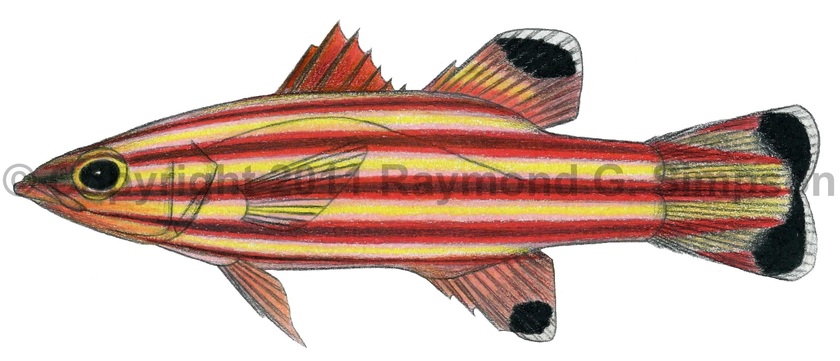
Common Name
Peppermint Basslet
Year Described
Poey, 1861
Identification
Dorsal Fin: VIII, 12.5
Anal Fin: III, 8
Pectoral Fin: 12-13
Pelvic Fin: I, 5
Gill Rakers: 16-18 (first arch)
Lateral Line Scales: 48-49
Vertebrae: 24 (10 precaudal, 14 caudal)
Body elongate, compressed, and robust. Head pointed. Forehead profile straight. Eye moderate to large. Mouth extends to rear half of orbit. Lower jaw projects. Rear corner of maxilla with a blunt ventral projection. Preopercle serrated. Opercle with one stout middle spine and two accessory spines. Spiny and soft dorsal fins appear well separated, with 6th and 7th spine very short. Dorsal, anal and caudal fin with rounded tips. Caudal peduncle strong. Tail slightly forked with rounded lobes. Body and entire head with small ctenoid, deciduous scales. Fin membranes scaled.
Color
Body with 4-5 dark reddish brown stripes about as wide as the interspaces, which are yellow with pinkish stripes above and below. This pattern runs onto caudal fin. There are two black blotches on the caudal lobes, connected with a narrow black submarginal line and a white posterior border. Fins are pale reddish. A dark blotch is present on the second dorsal and the anal fins. Tips of these fins bright white. Eye gold and red.
Size
Maximum size to 80mm TL.
Habitat
Coral reefs and deep rocky reefs from 2-70m.
Range
S. Florida to Venezuela, including the Gulf of Mexico and the Caribbean Sea. Also Bermuda.
References
McEachran, J.D. and J.D. Fechhelm. 2005. Fishes of the Gulf of Mexico. Volume 2: Scorpaeniformes to Tetraodontiformes. University of Texas Press, Austin. i-viii +1-1004.
Randall, J. E. 1963. Three new species and six new records of small serranoid fishes from Curaçao and Puerto Rico. Studies on the Fauna of Curacao and other Caribbean Islands v. 19 (no. 80): 77-110, Pls. 1-3.
Other Notes
The genus Chorististium had been erected in the past for these smaller Liopropoma with more separated dorsal fins (rubre, carmabi, mowbrayi, eukrines in our area). The genus Pikea was used for larger Liopropoma with notched but noticeably connected dorsal fins (aberrans, olneyi, santi in our area). Recent phylogenetic work shows Liopropoma is paraphyletic with the inclusion of Bathyanthias in the phylogeny, so they will eventually all be lumped into Liopropoma or several new genera will be proposed for the different clades.